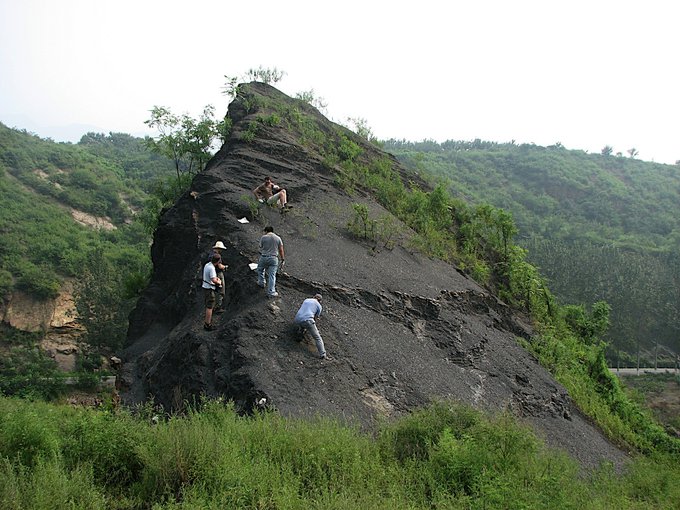
Jan. 10, 2017
Research Highlight
A Fertilizer Dearth Foiled Animal Evolution for Eons?
End of phosphorus dearth in ocean shallows coincides with evolutionary surge in study of 3.5 billion years of Earth’s history

These 1.9 billion-year-old marine sediments are from the East Arm of the Great Slave Lake, Canada. Thousands of samples for this study were collected from the few places on Earth that have such remaining slivers of ancient seafloor. Credit: Georgia Tech / Yale - Reinhard / Planavsky
For three billion years or more, the evolution of the first animal life on Earth was ready to happen, practically waiting in the wings. But the breathable oxygen it likely required wasn’t there, and a lack of simple nutrients may have been to blame.
Then came a fierce planetary metamorphosis. Roughly 800 million years ago, in the late Proterozoic Eon, phosphorus, a chemical element essential to all life, began to accumulate in shallow ocean zones near coastlines widely considered to be the birthplace of animals and other complex organisms, according to a new study by geoscientists from the Georgia Institute of Technology and Yale University. The paper, “Evolution of the global phosphorus cycle,” was published in the journal Nature, with research funded by the National Science Foundation, the NASA Astrobiology Institute, the Sloan Foundation and the Japan Society for the Promotion of Science.
Along with phosphorus accumulation came an oceanic chemical chain reaction, which included other nutrients, that powered organisms to pump oxygen into the atmosphere and waters. Shortly after that transition, which in geohistorical terms can mean about 100 million years, waves of climate extremes swept the globe, freezing it over twice for tens of millions of years each time, a highly regarded theory holds.
The elevated availability of nutrients and bolstered oxygen also likely fueled evolution’s greatest lunge forward.
After billions of years, during which life consisted almost entirely of single-celled organisms, animals evolved. At first, they were extremely simple, resembling today’s sponges or jellyfish, but Earth was on its way from being, for eons, a planet less than hospitable to complex life to one bursting with it.
Earth’s true genesis
In the last few hundred million years, biodiversity has blossomed, leading to dense jungles and grasslands echoing with animal calls, and waters writhing with every shape of fin and color of scale. And most every stage of development has left its mark on the fossil record.
The researchers are careful not to imply that phosphorous necessarily caused the chain reaction, but in sedimentary rock taken from coastal areas, the nutrient has marked the spot where that burst of life and climate change took off. “The timing is definitely conspicuous,” said Chris Reinhard, an assistant professor in Georgia Tech’s School of Earth and Atmospheric Sciences.
Reinhard and Noah Planavsky, a geochemist from Yale University, who headed up the research together, have mined records of sedimentary rock that formed in ancient coastal zones, going down layer by layer to 3.5 billion years ago, to compute how the cycle of the essential fertilizer phosphorus evolved and how it appeared to play a big part in a veritable genesis.

Close-up view of layered sedimentary rocks representative of those used in this study. Each layer records a snapshot of the Earth system over millions to billions of years. Credit: Georgia Tech / Yale - Reinhard / Planavsky
They noticed a remarkable congruency as they moved upward through the layers of shale into the time period where animal life began, in the late Proterozoic Eon.
“The most basic change was from very limited phosphorous availability to much higher phosphorus availability in surface waters of the ocean,” Reinhard said. “And the transition seemed to occur right around the time that there were very large changes in ocean-atmosphere oxygen levels and just before the emergence of animals.”
Phosphorus at the beach
Reinhard and Planavsky, together with an international team, have proposed that a scavenging of nutrients in an anoxic (nearly O2-free) world stunted photosynthetic organisms that otherwise had been poised for at least two billion years to make stockpiles of oxygen. Then that balanced system was upset and oceanic phosphorus made its way to coastal waters.
The work provides a new view into what factors allowed life to reshape Earth’s atmosphere. It helps lay a foundation that scientists can apply to make predictions about what would allow life to alter exoplanets’ atmospheres, and may inspire deeper studies, here on Earth, of how oceanic-atmospheric chemistry drives climate instability and influences the rise and fall of life through the ages.

Georgia Tech's Reinhard, Yale's Planavsky, and colleagues sample pieces of ancient seafloor in the field in order to reconstruct the long-term evolution of ocean-atmosphere chemistry on Earth.